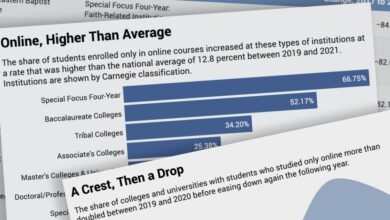Two Community Colleges That Reimagined the Student Experience Share the Top Aspen Prize

[ad_1]
At Amarillo College, students juggling classes with two part-time jobs were in danger of dropping out until the college connected them with employment tied to their coursework. At Imperial Valley College, another two-year college located in a region where unemployment rates are high and educational achievements low, classes that counted for both high-school and college credit were saving students time and money. Most importantly, the courses were persuading families that college was worth it.
At a time when community colleges nationally are struggling with declining enrollment and disappointing completion rates, two community colleges serving large rural sections of Texas and California are seeing impressive gains. On Thursday, Amarillo and Imperial Valley shared top honors at an awards ceremony in Washington, winning the Aspen Prize for Community College Excellence.
The $1-million prize, which the Aspen Institute has awarded every two years since 2011, is based on graduation and transfer rates, placement in decent-paying jobs, student learning, and equitable outcomes for low-income and minority students. The prize will be split between the two winners, and the competition is intended to highlight replicable models and practices for other colleges seeking to improve student outcomes.
Amarillo College was selected, in part, because of the success its graduates have found in the job market. Their average wages are $11,000 higher than those of other new hires in the region, the Aspen Institute noted. The judges singled out Imperial Valley because up to 80 percent of its dual-enrolled students attend the college at some point after graduation, and nearly all continue their educations somewhere. Transfer rates to four-year colleges are well above the national average.
“This year’s two Aspen Prize winners both serve large rural areas with high rates of poverty and low rates of educational attainment that, were it not for these colleges and their leaders, might not have the kind of hope for real change,” the Aspen Institute said in a prepared statement. Amarillo College is in a moderate-sized city in a red state; Imperial Valley in a small town in a blue state. Amarillo focuses heavily on getting students directly into the work force, the Aspen program noted, while Imperial Valley is largely working to get students into and through bachelor’s-degree programs. Both offer a wide array of academic and nonacademic supports, including required tutoring and help with housing, finances, and child care.
At both colleges, nearly 70 percent of enrollees are first-generation college students. Amarillo serves around 12,000 students, about half of whom are students of color. “Our students are struggling to make ends meet every day,” many working more than one part-time job, Amarillo’s president, Russell Lowery-Hart, said in an interview. “They’re going to be working anyway, and one of the ways we’ve been able to keep them in school is if their work is tied to the classroom.”
Someone interested in becoming a regional planner, for instance, could apply the part-time work they were doing for a local architect in a drafting course. These “earn and learn” connections, over the course of one to two years, can help students pay for college, earn credits, and gain professional experience.
“We’ve also completely reimagined the way we engage with employers,” Lowery-Hart said. Instead of inviting representatives of local companies to see how students are being taught, “we take students and faculty to employers on the floor or in the office and actually see what they’re doing and make sure our curriculum aligns with what they need from employees.” For instance, in the college’s partnership with Bell helicopters, “Instead of having Bell come and see our aviation mechanics training, our faculty went and watched Bell’s line build out a helicopter. Our curriculum now reflects the skills we saw on the line.”
Amarillo College’s new learning center, Innovation Outpost, helps students explore different technology careers, learn job skills, and connect with experts and industry professionals in fields like cybersecurity and data analytics. Classes teach job-specific skills in fields that also include robotics, artificial intelligence, and virtual reality. Some of the jobs students are preparing for can be done remotely, but Lowery-Hart also hopes that having a trained work force will persuade other high-tech companies to move to Amarillo.
Two-year public colleges enrolled 4.5-million students in fall 2022, down 25 percent from the 6 million enrolled in 2017. Enrollment stablilized in 2022 after two years of sharp declines during the pandemic. That’s partly a result of the growing presence of high-school students who take classes that count for both high school and college credit. Dual-enrollment students now account for about one in five community-college students.
Dual enrollment has been a lifeline for Imperial Valley College, and for the families it serves. The college is in an agricultural region of southern California that is one of the most economically distressed regions of the state. It began its dual-enrollment program in 2017 at a handful of high schools, and has since expanded it to every comprehensive high school in the region. Nearly 1,500 students from nine high schools were in dual-enrollment classes this academic year. Imperial Valley serves 7,800 students, 93 percent of whom are Hispanic.
Most classes are taught by community-college teachers who come to students at the high schools. Students can start taking classes as early as ninth grade, and the average dual-enrolled student graduates from high school with seven college credits under their belts. Some have as many as 30. The average course success rate is more than 80 percent.
Although the classes are taught in their high schools, “We treat them as college students,” Victor C. Torres, associate dean of work-force development and nontraditional instruction. said in an interview. “We have field trips to our campus so they get an ID, and we build relationships not only with the students, but their parents.”
With the stiff competition to be admitted to California State University and University of California campuses, “they like the fact that this gives them a competitive advantage.”
Up to eight out of 10 of the dual-enrolled students enroll at Imperial Valley at some point after graduation. Many do so, Torres said, because they’re so familiar with the college, have toured the campus, met faculty, and had staff members helping them along the way. “We spend an enormous amount of time servicing students from recruitment to application to orientation,” he said. “If they have trouble logging in or registering for class, we’re there to help. We’re on a first-name basis with students before they step foot in the classroom.”
Because of the academic plans many have devised, with the help of high-school and college counselors working together, many students are eyeing four-year degrees from the start. Transferring from a two-year college to a four-year institution can be challenging, and nationally, only 43 percent of students intending to transfer earn a bachelor’s degree within six years, according to the National Student Clearinghouse Research Center. At Imperial Valley, more than half do so.
[ad_2]
Source link






